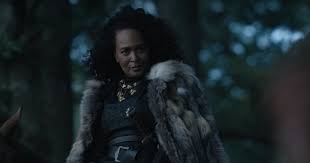How ‘Vikings: Valhalla’ Star Caroline Henderson Saw Herself in a Warrior Queen
Destiny Jackson, Netflix, February 25, 2022
In the new series Vikings: Valhalla, the diverse city of Kattegat might seem like an outlier to those who aren’t familiar with Viking history. But fact is closer than fiction. In the show, a war rages between the Vikings and the English over political indifferences rooted in intolerance of religious worship and other cultural practices. In the midst of the fray is a seaside province ruled by Jarl Estrid Haakon, a Black Scandinavian ruler who manages to strike a balance between the tense intermingling of religions and the vibrant intercultural exchanges in the port city’s open-air marketplace. In real life, and as depicted on the show, Vikings often traveled and settled down all around the globe in the Middle Ages, stretching across Constantinople, Russia, North Africa, Spain and even Canada. While other characters are based on real people, Estrid Haakon is an invented character, whose Viking grandfather met her royal African grandmother while in the great trading city of Alexandria, Egypt. They fell in love and returned to Kattegat, eventually passing on ruling duties to her.
“I can really relate to Jarl Haakon,” singer-actor Caroline Henderson, who channeled her own multicultural heritage in playing the royal leader, tells Tudum. “As a child, I was a little bit confused, I must admit, but I think I can really relate to her. I am Jarl Estrid Haakon, just a thousand years on.”
The common vision of Vikings has seldom included the truth, that the transnational empire was more diverse than modern media often depicts. “The Vikings were not a necessarily homogeneous, fully white group of people; they were multicultural and multiracial,” says series creator Jeb Stuart. “The Vikings went all over the globe: We know, from DNA evidence, that there’s Viking DNA all around what we considered the known world in the Middle Ages; we know that they were in Palestine and Constantinople.”
{snip}
Tríona Sørensen, Ph.D., a curator of the Viking Ship Museum in Roskilde, Denmark, told Tudum that the archeological record also further shows the influence of the Vikings’ vast trade routes. “You see this clearly in the archeological record here in Scandinavia — in silver coins from Arabic lands, precious metalwork from Ireland and Britain, silks from the East — all items that made their way to Scandinavia via maritime trade networks.”
Since the Vikings didn’t have a written language, or many depictions that weren’t made by folks they defeated, we have little knowledge of what they looked like. But we do know that Vikings were a constantly changing kingdom. “Ethnicity is always a thorny subject, but I think one thing that typified the Viking expansion was their ability to adapt when they settled outside of Scandinavia,” she says. “This dynamic, vibrant culture [that] burst onto the pages of history at the end of the eighth century doesn’t just disappear, it evolves, it adapts and turns into something new.”
Though conversations around ethnicity can be tricky to navigate, Henderson isn’t afraid to address misconceptions about Vikings being thought of as just a homogenous group.
“They were not this little isolated colony up north,” Henderson says. “They traveled all over the world. There might have been a Black Jarl Haakon, a Russian Jarl Haakon or somebody from Asia or a Native American. There is so much research you can dig into.” With Henderson’s prominent role, audiences will experience a new vision that reveals an inclusive view that has its roots in reality.
Here, Henderson talks about how her own multicultural upbringing helped her reign supreme on Vikings: Valhalla as the valiant, regal Jarl Haakon.
{snip}
What would you say to those who say a Black woman can’t be a Viking queen? I would say that you should do your research, because [even though] Jarl Haakon is a fictional character, but most likely there [have] been people of color [who ruled]. We know that through DNA [and] research. We know for a fact that they mixed and traveled all over the place, much more than what we knew 100 years ago. Now we actually know, through science, that [Vikings] were really travelers and of course they mixed cultures and babies and knowledge and foods and slaves and, yes, of course, they were mixed. They were not this little isolated colony up north. There might have been a Black Jarl Haakon or a Russian Jarl Haakon or somebody from Asia or Native American, most likely. If you want to know about stuff, what really happened, there’s so much research and interesting stuff that you can dig into.
{snip}

Jarl Haakon















